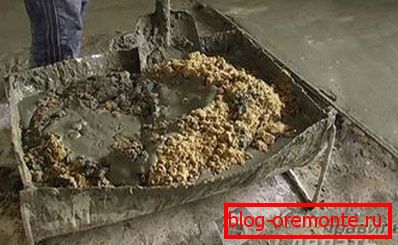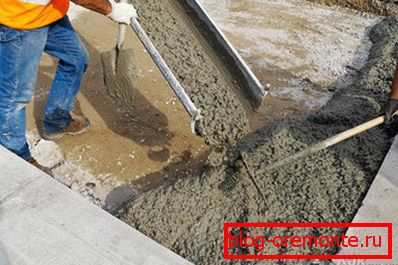How to make concrete
The preparation of high-quality concrete is impossible today without the use of technologies that have been developed over the years, which will allow you to get a mixture with the specified technical characteristics. The preparation of a working concrete mix is usually carried out in several stages, at each of which strictly regulated operations are carried out with the components included in its composition. A list of these operations can be found below:
 preparation of fractions entering concrete (gravel, gravel and sand);
preparation of fractions entering concrete (gravel, gravel and sand);- mixing fractions of gravel and gravel in the required proportion;
- mixing sand fractions in the required proportion;
- getting sand and gravel (aggregate);
- adding the required amount of binder (cement);
- mixing the resulting mixture and adding the right amount of water;
- final mixing of the finished concrete mix.
Preparation and mixing of fractions

The decision on how to make concrete correctly begins with the proper preparation of its fractions. For this, gravel and crushed stone, which are the initial components of the building concrete mix, are sifted with a given sequence through special filtering grids with cells of different grain sizes.
By phasing through three different grids, it is possible to obtain three independent fractions from the initial gravel mix, each of which contains particles of “its own” size. The mixture of these fractions is the initial gravel component, which is then used in the manufacture of concrete.
 Depending on the requirements for the ready-mixed concrete, there are several schemes for mixing the fractions obtained from gravel, expressed as their percentage. The most widely used variant of the mixture, compiled from fractions according to the scheme 60 + 30 + 10 (in percent). In the case of the preparation of 2 fractional mixtures, the classical scheme of their mixing in the proportion of 30 + 70 percent is usually used.
Depending on the requirements for the ready-mixed concrete, there are several schemes for mixing the fractions obtained from gravel, expressed as their percentage. The most widely used variant of the mixture, compiled from fractions according to the scheme 60 + 30 + 10 (in percent). In the case of the preparation of 2 fractional mixtures, the classical scheme of their mixing in the proportion of 30 + 70 percent is usually used.
The sand component for concrete is prepared in the same way as the previously considered gravel component. At the same time, the source material (preferably river sand) is sifted in the same way through a number of special nets with appropriate graininess. As a result of such screening, sand particles are divided by the size of sand grains into fine-grained and coarse-grained fractions. Their percentage ratio is usually determined by the requirements imposed on the characteristics of the finished concrete mix in each particular case.
Final preparation of concrete

Prepared in accordance with the requirements of existing standards and thoroughly mixed sand-gravel mix (ballast) will allow you to end up with a sufficiently dense and high-quality concrete, costing a minimum amount of cement component. When preparing it, it is recommended to adhere to the following recommendations:
- The components used are best measured by parts of the volume in a certain proportion; for example, 1: 6 (the smallest figure shows the cement content). At the same time, the redundancy of cement will not improve its quality, and the disadvantage will noticeably lower the density.
- Cement is desirable to take the brand, the symbol which is 2-3 times the planned class of concrete. For concrete M150, for example, it is best to use cement grade 400.
- In the process of mixing the finished composition dosing of cement and sand is best done using a measuring bucket. Since in the course of work you will have to add new and new portions of the components of the solution all the time - count the amount of the finished mixture so that the whole batch is consumed immediately. It is very important that the entire solution be uniform in quality, that is, would have in the ready state the same, even color.

In the case when you make foundation concrete (the proportion of ballast and cement is 1: 5) - it will be easier and faster to work with the concrete mixer. In this case, the decision on how to make concrete is implemented as follows. First, water is poured into the mixer, to which cement is added. After the addition of sand and gravel, kneading should continue until the concrete mass becomes homogeneous in appearance. Water in the composition should be added as long as the solution does not become quite plastic appearance (but it will not look excessively liquid).
The consistency of the concrete should resemble liquid clay.

In the manual preparation of concrete act, as a rule, as follows:
- First, five dimensional ballast buckets are poured onto a wooden pallet.
- Then one bucket of cement is added on top and this mixture is stirred with a shovel until a uniform gray color is obtained.
- At the top of the hillock the mixture is deepened, and water is gradually poured into it with simultaneous stirring of the dry mixture in it.
Video
One of the methods for producing concrete is presented in the following video: